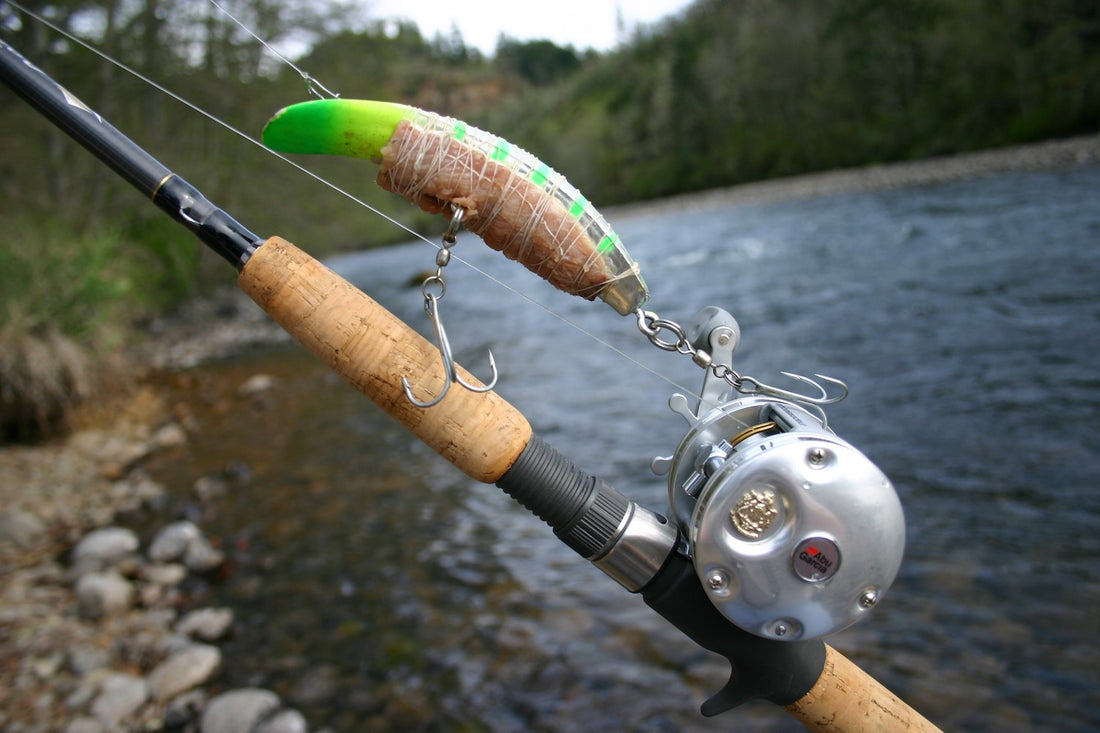Within a couple of minutes after his plug disappeared in the dark green water of the Chetco River, Rich Ariza felt a violent jerk on his rod. The tip dipped down, lifted up again, then buried over. There was a big splash right in front of the boat. Line began to scream off of Rich’s reel...
The scene repeated itself over and over for Rich and his son Johnny, who fished with me early last fall. In the first couple of hours of fishing, the two hooked six salmon, and landed three in the 30- to 40-pound range. During that time, the pair learned several of the do’s and a few of the don’ts of running plugs for salmon.

Here are 10 keys to catching more salmon on plugs.
- The Set Up
Perhaps the biggest mistake I see people make when pulling plugs for fall kings is completely missing the fish when they come through a likely holding area.
On many rivers, some of the best pools for salmon are located in the deeper water just downstream from a faster riffle. Salmon will often hold at the top of these pools, right where the deep water begins to shallow up.
I’ve seen many boaters drift into a pool and by the time the anglers get their plugs out, they are already downstream of the fish. Remember, if you let out 50 feet of line, that’s nearly the equivalent of three boat lengths.
A good set up is vital to catching more fish.
Slow the boat down as quickly as you can when you come down a riffle to a hole, and get the plugs in the water so they are working as soon as they hit the seam where the river slows down and begins to deepen.
If you wait until the boat gets to the spot you think the fish may be, it may be too late, as your plugs will be well downstream from that point. Ideally, you want to have the plugs fishing well ahead of where the fish are, and slowly slip down to the sweet spot.

- Wait, wait, wait...
It happens all the time.
An angler is holding his or her rod and a big king smacks the plug. For many beginning salmon fishermen, it’s the hardest strike they’ve ever felt. They immediately jerk back, and the fish is gone.
Wait until a salmon is taking line off your reel before setting the hook.
Get 4 Mag Lip Plugs - a Salmon Plug Book and 1 Year STS Subscription
By then the fish is already hooked and you have the highest odds of landing it. Even after a couple of really hard whacks, a salmon can still spit the plug. Often a salmon is still swimming upstream when it grabs a plug by its back. Kings will usually chomp on a plug several times and then clamp down and turn, burying the hooks in their jaw as they change directions and run downstream.
Many guides will urge their customers to use rod holders when fishing plugs. If you don’t use the holder, at least rest the rod against the gunnel as you hold the rod across your lap. Then make sure you wait, wait, wait.
- Keep ‘em Fresh
Starting the day with a fresh sardine wrap and then replacing the wraps every 45 minutes to hour will result in more strikes.

Salmon will hit plugs without a bait wrap - it happens all the time on the Kenai early in the season before bait is allowed - but adding a sardine fillet will increase the number of fish you hook.
The fresher the fillet the better. I usually launch a few minutes early and wrap four plugs, two to begin fishing immediately, and a few more for back-ups once a fish is hooked, or when it’s time for a refresher.
Don’t wrap the plugs too early. You want them to be juicy and fresh when they hit the water, not dried out.
As soon as the bait wrap turns brown, replace it with a fresh one. Adding scents such as krill, herring oil, anise or sand shrimp oil can also help attract more fish.
If you are switching back and forth from back-bouncing or divers to plugs, put on a fresh wrap before putting the plugs back out. There have been numerous times when I’ve been fishing a hole and then put on fresh wraps and hooked up almost instantly.

On a typical day with two customers, I’ll often use a whole tray of sardines, getting two to four baits from each fish.
- 'Sticky' Sharp
You’d be surprised how many anglers run plugs with dull hooks. A plug out of the package has super sharp hooks. But once it’s been used a few times, or caught a few fish, the hooks will dull.
The sharper the hooks, the more fish you’ll hook, and land. I touch up the hooks on my plugs every day with a few swipes against a file.
If you replace hooks, use a similar size to ensure the plug will run the way it was intended to.

Aside from the sharp hooks, I make sure the plugs are clean. At the end of the day, each plug gets a scrubbing with toothpaste and a toothbrush to get all the oils, unwanted scents and dried bait off.
- Wall of Death
Although it’s not quite as important as it is when running plugs for steelhead, you should have all your salmon plugs out the same distance. Line counter reels will take all the guess work out of this, but you can also count passes on the level wind.
Before I started using line counters, I’d let out anywhere from four and a half passes to seven passes. A pass is simply left to right, or right to left, one time across. Four and a half passes is around 35 to 40 feet, while seven is usually a little more than 50 feet, depending on line diameter.
Of course, in deeper water you may have to let out a little more line.

By having all the plugs out the same distance, you ensure you are maximizing your presentation. There are also times when a salmon sees the first plug and moves to the side instead of hitting it, only to run into the next plug and strike it as its first reaction.
- Tipping Plugs
The last few years “tipping” plugs with Berkley Gulp! worms has gained in popularity. The added action of a worm twirling around behind the plug seems to produce a few more hookups. Buzz Ramsey of Yakima Bait Co. has found tipping plugs to be particularly effective.
Some anglers also add a small hoochie or squid to the rear hook.

I was on the Sixes River last December and nobody was finding many fish. I remember using stretchy thread to add an orange and green Gulp! crawfish to the rear hook. One of my clients nailed a fish on the first pass with the crawfish-enhanced FlatFish. The other two fish we landed that day also came on the tipped plugs.
- Slower is Better
When running plugs through a likely salmon hole, slow it down. Slower is better. When you quickly move through a pool, a fast presentation may not get any of the fish to bite.
But a slow, methodical pass down the slot will often lure the aggressive and territorial fish into striking.
Salmon don’t like a 5- or 6-inch lure dancing in front of their face very long. If it stays there, they will often try to remove it.
I like to watch the rod tips and make sure the plugs are working, and then stroke enough to barely hold the boat in place and drop down a foot or so every 10 or 15 seconds, sometimes even slower. The slower you go, the deeper the plugs will dive.

If there are a lot of fish in a run, I want to spend as much time there as I can.
- Seams, Pockets and Drop-offs
Any place you have a sudden change in depth or speed you have a chance of finding salmon. In long runs, salmon will often hold behind large boulders, changes in depth (which create a slight current break) and along the seam between the fast water and slower water.
Some of the obvious salmon spots are along steep banks and rock walls, opposite the gravel bars. Salmon like 5 to 10 feet of water where the current is slow enough they can comfortably hold.
In faster stretches, salmon may still be there, holding behind large rocks, logs or along the underwater eddy created by a sudden increase in depth.
- Getting Down
In water more than 10 feet, you may need to add a diver, dropper with weight or use a deep-diving plug. The last few years, Yakima Bait Co.’s Mag Lip, which is a modified Flat Fish, has been hot for deeper, faster runs. The Mag Lips dive to 18 feet, and the “skip-beat” has proven to trigger strikes.
If I’m using a T50 FlatFish or a K15 Kwikfish in fairly deep water, I’ll place an 18-inch dropper four feet above my plug and use two or three ounces of lead to get it down. Back-bouncing plugs takes a little getting used to for some people, but is effective for pulling fish out of the deeper slots.

- Rower’s Rod
Little is more exciting than rowing and hooking a big king at the same time. To get a third rod out while fishing two people up front, I’ll let a plug out and then sit on the rod butt with the rod resting against the gunnel just in front of the oar lock. I’ll point the rod straight out the side to keep it away from the front rods. I can also quickly reel with the rod in this position.
Having three lines instead of two obviously increases your odds of hooking up.
---------
- Written by Andy Martin
Andy Martin is a full-time Oregon, California and Alaska fishing guide. His home waters are the Chetco, Elk and Sixes rivers.
www.wildriversfishing.com.



4 comments
My first year trying Salmon.. very useful tips, especially adding canned tuna oil to the club spawnwich ..👍
It’s good to know that in more than 1 0feet of depth you might need a weight to catch the salmon. My grandpa used to take me salmon fishing when I was younger and I want to get back into it. I think it would be such a fun activity to do with my kids as well. https://www.riptide.net/Reservations-Pricing
Nice informative article thanks
Nice Article,You Nailed It,I have Been A Salmon Guy For 30 Years